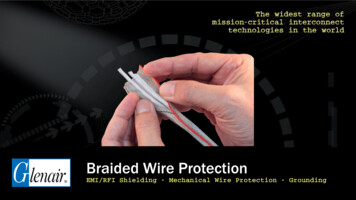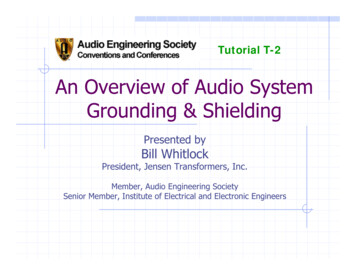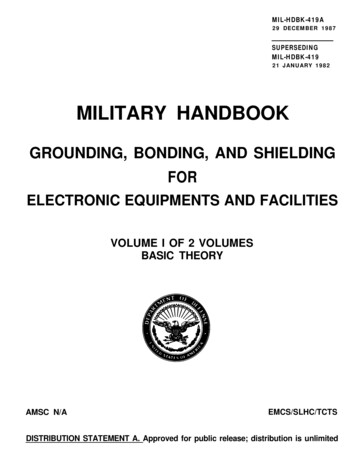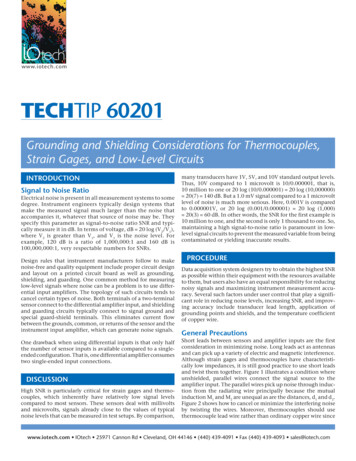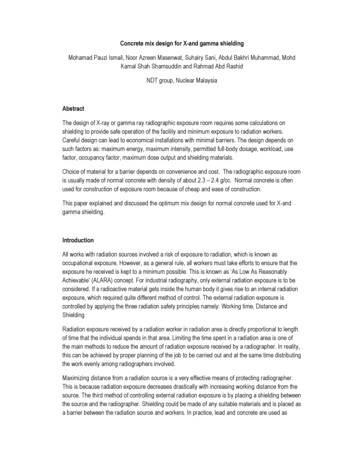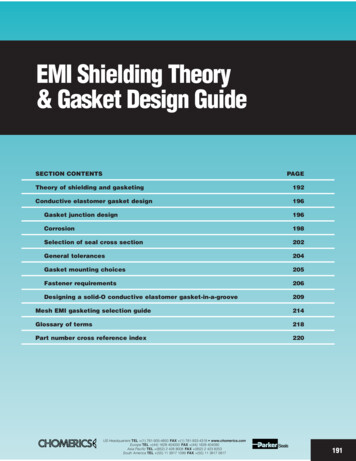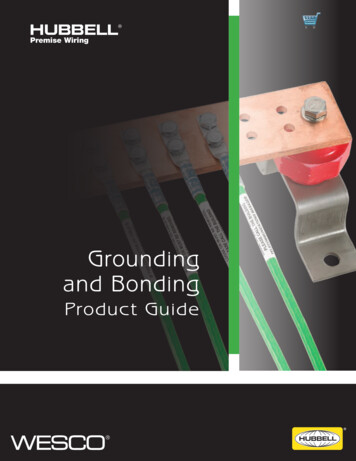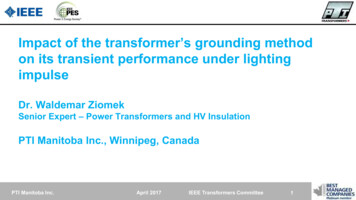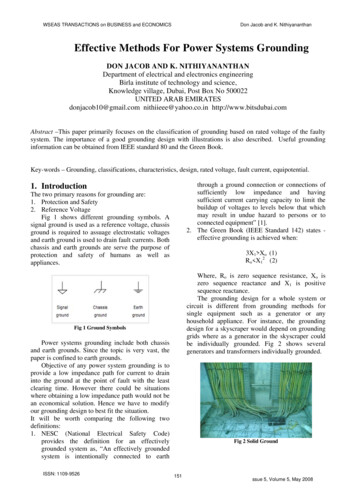
Transcription
Chapter 2Grounding & ShieldingSafety, system protection and performance are the three main reasons to earth asystem. Not all electronic equipment needs to be connected to earth to work,satellites are an example. Sometimes wrong grounding configurations, oriented tosatisfy the special power and performance requirements of electronic loadingequipment, can compromise safety rules generating dangerous situations forpersonnel and equipment. Personnel safety, equipment safety and performancegrounding issues have to be analyzed together. In any case, safety rules must not beviolated. All these concepts as well as the relations between ground issues need tobe clarified before passing on to a higher level in the control of the electromagneticemissions of the system. Along the present chapter, concepts like safety grounding,signal or ground reference plane as well as grounding topologies to achieve electricsafety and good performance of the system, are presented. The characteristics ofshield structures, shielded power cables as well as their connections to ground arealso presented. Finally in the last section, some recommendations to design theCMS detector grounding are included. The grounding design of the detectorconstitutes the first of several steps to be followed for the detector integration undera electromagnetic compatibility plan.2.1 Grounding generalitiesAs described in [1] [2] and [3], proper grounding techniques are necessary for safety,equipment operation and performance. The integrity of both the facility groundingand the proper equipment operation depends on the proper bonding of thegrounding electrode system, proper system grounding of service equipment andseparately derived sources and proper equipment grounding for operationalfrequencies (DC or AC-mains) as well as higher frequencies. It is recommended thatthe grounding design and installation be compliant to all applicable codes andstandards [4][5]. The grounding is not designed as an active component of thepower supply (PS) distribution system, hence this path must be free of anyoperational current.47
2. Grounding & ShieldingMetal parts of equipment enclosures, racks, raceways and equipment groundingconductors susceptible of being energized by electrical currents (due to circuitfaults, electrostatic discharge, and lightning), must be effectively grounded forreasons of personnel safety, fire hazard reduction, equipment protection andequipment performance [6][7]. Grounding these metallic objects facilitates theoperation of over-current protective devices during ground faults and permitsreturn current from electromagnetic interference filters and surge protectivedevices, connecting line to ground or line to chassis, to flow in proper fashion. Allmetallic conduits and raceways in areas containing electronic load equipment haveto be carefully bonded to form an electrically continuous conductor.All mechanical equipment in the electronic equipment areas should be carefullybonded for an electrical safety and for noise current control. Such equipment shouldbe grounded or bonded to local building steel using direct or higher frequencygrounding and bounding means. When located in the same area as the electronicload equipment, mechanical equipment should be bonded at multiple points to thesame ground references as the electronic load equipment. Heating, ventilation, airconditioning, process cooling equipment, related metal piping and electricalconduits are recommended to be bonded to the same ground reference serving theelectronic load equipment.Once the grounding complies with the safety rules, the ground connections have tobe improved to obtain a good performance of the system. It is important to keep inmind that for operational reasons one should imagine that at low frequencies theground system is a kind of low resistive divider in which all noise currents usuallyflows everywhere. However at high frequency the ground impedances start toincrease mainly due to the inductive effect, flowing the noise only through thelowest impedance path. Therefore, the ground connections should be tackled in twosteps. The first step is oriented to low frequency currents where it is important toavoid ground loops because once these currents are established they can floweverywhere, decreasing the performance of the system. The second step is focusedon the noise at high frequency, where one could imagine that everything in thesystem is connected (through real or parasitic impedances) designing the groundpath and connections in an specific way that gives a low impedance path to HFnoise currents and thus avoiding the flow of these currents through sensitive partsof the system.48
2.2. Grounding for fault and personnel protection.2.2 Grounding for fault and personnelprotection.2.2.1 System grounding or earthingSystem grounding or earthing involves the ground connection of power servicesand separately derived systems. They include generator, transformers,uninterruptible power systems (UPS). The system earthing is the intentionalconnection of a circuit conductor (typically the neutral on a three phase, four wiresystem - Protective earth (PE)) to earth. The purpose of the system grounding [3] isfor electrical safety of personnel and equipment as well as fire safety reasons. Safetyis basically governed by the electrical codes and standards as adopted bygovernment agencies and commercial entities. System grounding also impacts theperformance of electronic load equipment for reasons related to the control of thecommon-mode noise and fault currents, however the personnel and the equipmentprotection is the primary task of the grounding as it is described in [8].The grounding of power systems is, from a safety standpoint, oriented to limit thepotential difference between grounded objects, to provide a good operation ofover-current protective devices in case of ground fault, to stabilize the phasevoltages with reference to ground and to limit transient voltages due to lightningand load switching.There are two basic requirements for grounding power services and separatelyderived systems or sources (transformer, generators, UPSs, etc.). The firstrequirement is to bond the neutral or secondary grounded circuit conductor to theequipment grounding terminal or bus. For power services entrances, the incomingneutral conductor is connected to the equipment grounds bus in the switchboard bymeans of the main bonding jumper. For separately derived sources, the neutralmust be bonded to the equipment grounding terminal or bus. The secondrequirement is that the equipment grounding terminal or bus must be connected tothe nearest effective grounded electrode by means of the grounding electrodeconductor. To illustrate the grounding connection of a separately derived source,figure 2.1 shows the grounding connection for an isolation transformer. If noeffective grounded electrode or building steel is available, then the separatelyderived source should be connected to the service entrance grounding point via agrounding electrode conductor installed in the most direct and shortest pathpracticable. In the case that metal interior piping is present near the separatelyderived source, a supplemental grounding electrode conductor should also beinstalled from the equipment grounding terminal or bus of the separately derivedsource to the metal interior water piping.49
2. Grounding & ShieldingFigure 2.1: Isolation transformer grounding layout.From a performance standpoint, solidly grounded power systems arerecommended practice to ensure the existence of effective conductive paths for thereturn current of filters and surge protective devices connected line to ground orline to chassis. These filters and surge protective devices may be an integral part ofthe electronic load equipment or may be separately mounted devices located in thebuilding electrical distribution system. It is recommended in the design to aim atthe lowest reasonable impedance between the load equipment containing a filter orsurge protective device and the associated power system source. Low-inductancewiring methods should also be used.2.2.2 Equipment groundingAs described in [9][10][11] and [12], electrical or electronic circuits do not need to beearthed in order to work. Satellites, spacecraft and mobil phones, all work properlywithout earthing. The earthing or system grounding is a requirement necessary forsafety. Electrical safety concerns all electrical design work. Safety requirementscannot be compromised to satisfy the special power and grounding requirements ofelectronic loading equipment. One should always try "to make the system design safeand then try to make it work". This ground philosophy is widely explained in [7], [13]and [14].The term "equipment grounding" refers to the connection to power system groundof all non-current carrying metallic parts of a power system that may come intoaccidental contact with circuit phase and neutral conductors. These metallic partsinclude raceways, conduits, equipment grounding conductors, equipment50
2.2. Grounding for fault and personnel protection.enclosure and racks. All these items are ultimately grounded together at thegrounding electrode of the power service or a separately derived system.Equipment grounding is required for both personnel safety and power systemsprotection. From a personnel safety point of view, properly grounded systemcomponents minimize potential differences that may exist between various systemcomponents under transient and fault conditions. From a system protectionstandpoint, properly grounded system components provide a low impedance pathfor ground fault currents and promote the timely operation of over-currentprotective devices in case of ground faults.There are two different grounding configurations associated with the connections ofthe equipment to the PE point; the standard ground configuration and the insulatedground configuration. For the standard equipment grounding configuration, a supplementary groundconductor provides an additional low impedance ground path in parallel withthe metallic conduit or raceway from the equipment to the power system. For the isolated grounded configuration, the electronic or electrical load is notconnected to the metallic enclosure and this metallic enclosure is earthedthrough an independent conductor to the start point of the safety ground. Theinsulated equipment grounding conductors run with the other circuitconductors feeding electronic load equipment. In an isolated groundconfiguration, the additional equipment grounding conductor provides the solegrounding path from the electronic or electrical load equipment to the powersystem or separated derived system.In either case, the insulated equipment grounding conductor should run in thesame raceway or conduit as the phase and neutral conductors. Groundingconfigurations provide equalization of potentials between grounded objects at theoperative frequency. As the frequency increases, other grounding means must beconsidered to cover the high frequency range.Robust design of the electronic load equipment for immunity to disturbances on thegrounding circuit is a good method to get a good grounding [15]. Particularly fordistributed computing and telecommunication electronic loads, using opticalsignaling interfaces reduces the sensitivity to disturbances on the ground circuit. Asit is implemented in the CMS detector, the processed data from the detector istransmitted out of the detector via optical devices, and the slow control signals areisolated from the detector via opto couplers.2.2.2.1 Standard equipment groundingThe standard equipment ground configuration [13][14][16] uses one equipmentgrounding conductor (PE or G), in green color, running with the phase and neutral51
2. Grounding & Shieldingconductors to supplement groundedconfiguration is shown in figure 2.2.metalracewayandconduit.ThisFigure 2.2: Standard ground configuration.The standard equipment grounding conductors are usually sized according to thetable of standards for equipment grounding conductors and are properly connectedand bonded to each metal enclosure that it passes through from the separatelyderived system or power service to the electronic load equipment. These metalenclosures include all distribution panel boards, safety switches, circuit breakerenclosures, transformers and branch circuit panel boards, as well as pull boxes,junction boxes and metal outlet boxes.The conduit and raceway system may depend on the integrity of mechanicalconnections at conduit and raceways joints, panel boards, junction boxes and at thereceptacles themselves. The non-uniformity and bad performance of the groundingpaths can compromise personnel safety as well as the operation of surgesuppressors and filters located in the electronic load equipment. In addition,currents flowing on grounded surfaces may take less desirable paths, such usthrough load equipment and associated data cables. The purpose of the installedequipment grounding conductor is to increase the reliability of the grounded metalconduit system.2.2.2.2 Isolated groundingThe isolated grounding configuration [16][17] uses an insulated equipmentgrounding conductor, typically green color with yellow stripe, running with thephase, neutral and PE conductors from the electronic load equipment to theequipment grounding terminal of the power system or separately derived system.As opposed to the standard equipment grounding configuration, this additionalinsulated equipment grounding conductor typically connects the isolated ground52
2.2. Grounding for fault and personnel protection.receptacle (IGR) only to the equipment grounding terminal or bus of the powersystem source or separately derived system. This equipment grounding conductorextends radially downstream to the chassis of the electronic load equipmentwithout contacting any grounded metal surfaces such as metal conduits and raceways, p
Grounding & Shielding Safety, system protection and performance are the three main reasons to earth a system. Not all electronic equipment needs to be connected to earth to work, satellites are an example. Sometimes wrong grounding configurations, oriented to satisfy the special power and performance requirements of electronic loading equipment, can compromise safety rules generating dangerous .
